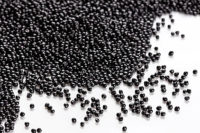This challenge is being overcome by the development of epoxies with ever-lower coefficients of thermal expansion that enable them to encapsulate high-power inverters without failure. For example, the 840 ventilator system, recently introduced by Nellcor Puritan Bennett (NPB), Carlsbad, Calif., has two large displays, both of which are powered by a single E2019 inverter from Endicott Research Group (ERG), Endicott, N.Y.
This and other high-power Endicott inverters use Insulcast 333 two-part epoxy from Insulcast Division of American Safety Technologies, Roseland, N.J. This epoxy has such an exceptionally low coefficient of thermal expansion that it has been able to withstand this critical and demanding application without a single reported failure in the field.
Critical Component
The NPB 840 is a good example of the trend towards larger displays. This medical device provides sensitive, precision breath delivery for critically ill pediatric and adult patients. Several innovative technologies have been introduced to make the system more user friendly, including two screens – one to monitor information and the other to make settings.The display is obviously one of the most critical components of the ventilator system. If it were ever to go black, medical personnel would be unable to monitor the patient’s vital signs and apply appropriate therapies. As with nearly all of the latest generation of displays, those used in the 840 are backlit with cold cathode fluorescent tubes (CCFT).
CCFTs are typically powered by DC-AC inverters – devices that convert the low-DC voltages used to power most electronic equipment to the high-AC voltages needed for backlighting. CCFTs typically require about 1,000 volts at startup and 400 to 500 volts during operation. Despite the fact that current draw is small, these devices still usually constitute the large power draw in most devices.
NPB worked with ERG to select the power supply for the unit. The majority of inverters used in low-end mass market have an open frame so that the coils used to generate the high voltages that power the CCFT are exposed to the air. This approach is worrisome in critical applications because the high voltages are exposed to the atmosphere. This raises concerns about arcing, which could cause a display failure as well as safety problems.
Epoxy Requirements
For this reason, the majority of the displays produced by high-end inverter producers such as ERG are encased in epoxy. This provides an extra layer of insulation for the high-voltage coil and protects against the possibility of shock. But the use of epoxy encapsulation raises another consideration. High-powered inverters generate relatively large amounts of heat, so they generate thermal cycles whenever the display is turned on or off.Conventional epoxies usually fail over time in these applications because their thermal expansion and contraction leads to cracks. NPB engineers consulted ERG engineers and asked them if they could resolve this problem.
ERG engineers provided the solution with two of their E200II series inverters – one for the 840 units using a black-and-white display and the other for color-display models. Unlike open-frame inverters evaluated by NPB, both of these inverters are capable of powering both CCFTs used in the 840. They are also specially designed to withstand the demanding thermal cycles that are characteristic of dual-screen applications. Don Jensen, ERG engineering manager, said that the key to the unusually high capacity of these inverters is the low thermal-expansion coefficient
of the epoxy used to encapsulate them.
Low Thermal Expansion
“When we designed these inverters, we knew that their ability to withstand high current loads without the encapsulation cracking would be critical to their success,” Jensen said. “We talked to Insulcast, our primary epoxy supplier, and asked if they could help us out. Insulcast told us that they had recently developed a new grade called 333 that was specially formulated to provide a low coefficient of thermal expansion for encapsulating relatively high-power electronic products. We tried it and discovered that it met all of our requirements with a considerable margin of safety.”Insulcast 333 is a rigid, low-viscosity epoxy compound that cures in combination with another Insulcast product, Insulcure 20, at room temperature. The epoxy compound can also be cured with several other compounds to accommodate special requirements. As well as a coefficient of thermal expansion of only 48 x 10-6°C, Insulcast 333 provides low system viscosity, which makes it ideal for potting small- to intermediate-size modules and circuits.
“This was an extremely challenging application, but fortunately we had the perfect tool in our box to handle it,” Jensen concluded. “As device manufacturers move to larger and more numerous displays, the demand for inverters that can handle high power requirements will continue to expand. From the manufacturer’s standpoint, one of the greatest challenges will be finding the right epoxy grades to handle the thermal cycles created by these requirements.
The close relationship between ERG and Insulcast has helped us meet this challenge. In particular, Insulcast’s engineering staff has worked closely with us to develop an encapsulation and curing process that eliminates damage to brittle ferrite cores. As display sizes continue to increase, this partnership will help us meet the needs of device manufacturers who want ever-larger displays.”
